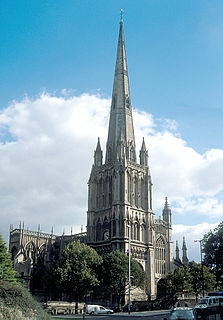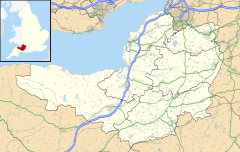
William Halfpenny was an English architect and builder in the first half of the 18th century, and prolific author of builder's pattern books. In some of his publications he described himself as "architect and carpenter", and his books concentrate on the practical information a builder would need, as well as addressing "gentleman draughtsmen" designing their own houses. They were a popular alternative to the very expensive architectural treatises by British authors such as Colen Campbell and James Gibbs, or foreigners such as Serlio or Palladio. He also wrote under the name of Michael Hoare.

Bristol, the largest city in South West England, has an eclectic combination of architectural styles, ranging from the medieval to 20th century brutalism and beyond. During the mid-19th century, Bristol Byzantine, an architectural style unique to the city, was developed, and several examples have survived.

Stanton Drew is a small village and civil parish within the affluent Chew Valley in Somerset, England, situated north of the Mendip Hills, 8 miles (12.9 km) south of Bristol in the Bath and North East Somerset Unitary Authority.

Charterhouse, also known as Charterhouse-on-Mendip, is a hamlet in the Mendip Hills Area of Outstanding Natural Beauty (AONB) in the English county of Somerset. The area between Charterhouse and Cheddar Gorge including Velvet Bottom and Ubley Warren is covered by the Cheddar Complex Site of Special Scientific Interest.

Wookey Hole is a village in Somerset, England. It is the location of the Wookey Hole show caves.

The Parish church of St Michael the Archangel is in the village of Compton Martin, Somerset, England. The church is a grade I listed building, and several of the monuments in the church yard also have listed status., The church is dedicated to St Michael the Archangel.
Babington is a small village between Radstock and Frome, Somerset, England, which has now largely disappeared.

The Grade I listed buildings in Somerset, England, demonstrate the history and diversity of its architecture. The ceremonial county of Somerset consists of a non-metropolitan county, administered by Somerset County Council, which is divided into five districts, and two unitary authorities. The districts of Somerset are West Somerset, South Somerset, Taunton Deane, Mendip and Sedgemoor. The two administratively independent unitary authorities, which were established on 1 April 1996 following the breakup of the county of Avon, are North Somerset and Bath and North East Somerset. These unitary authorities include areas that were once part of Somerset before the creation of Avon in 1974.

The Church of St John the Baptist in Axbridge, Somerset, England, was built in the 13th century and has been designated as a grade I listed building.

The Church of St Andrew in Compton Bishop, Somerset, England dates from the 13th century, being consecrated by Bishop Jocelin in 1236, with more recent restoration. It is a Grade I listed building.

The Anglican Church of St Peter and St Paul in Kilmersdon, Somerset, England, dates back to the Norman period, though much of the current structure was built during the 15th and 16th centuries and restored in the Victorian era. It is a Grade I listed building.

The Church of St Mary in Litton, Somerset, England, dates from the 13th century. It is a Grade I listed building.

The Church of St Matthew in Wookey, Somerset, England, dates from the twelfth century and is a Grade I listed building.

The Merchant's House at Number 8, Market Place, Shepton Mallet, Somerset, England was built around 1675 and has been designated as a Grade II* listed building. The date of construction was confirmed by dendrochronology.

The Church of St Margaret in Hinton Blewett, Somerset, England probably dates from the 13th century although parts are as late as the 16th or 17th century. It has been designated as a Grade I listed building.

The Mells River flows through the eastern Mendip Hills in Somerset, England. It rises at Gurney Slade and flows east joining the River Frome at Frome.

Babington House is a Grade II* listed manor house, located in the village of Babington, between Radstock and Frome, in the county of Somerset, England.

Mendip is a local government district of Somerset in England. The Mendip district covers a largely rural area of 285 square miles (738 km2) ranging from the Mendip Hills through on to the Somerset Levels. It has a population of approximately 110,000. The administrative centre of the district is Shepton Mallet but the largest town is Frome.


















